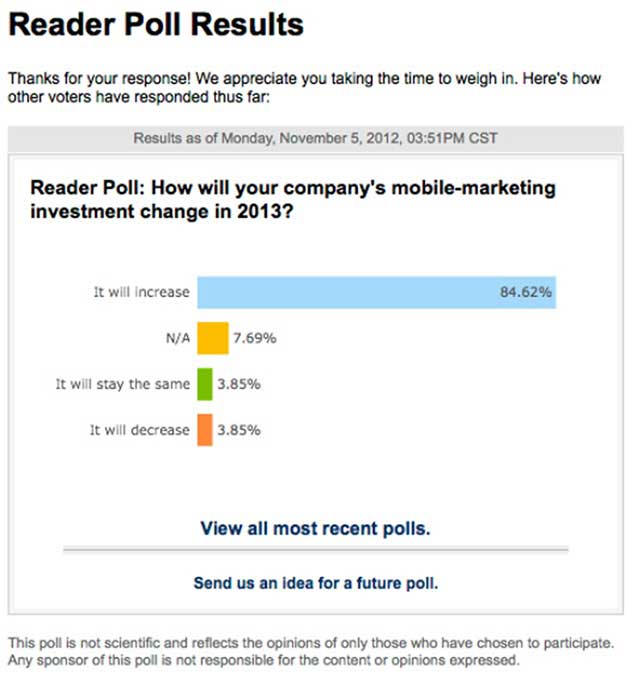Can your company afford to ignore the rapidly expanding mobile marketplace?
A recent poll from the Mobile Marketing Association (see Figure 1) confirms that disregarding the mobile market is a mistake that marketers want to avoid, and tech research firm Gartner finds that global sales of smartphones and tablets will surpass 1 billion units in 2013. ("Smart device sales to hit 1B next year," Mobile World Live); sales estimates for 2012 exceed 800 million.
As a marketer, are you ready to ease your organization into yet another cultural shift related to online marketing?
Yes, most of you have just finished with the social media shift and many are still working through the integration of analytics with your marketing programs. But, as noted by Pete Christothoulou, co-founder and president of Marchex, "Executives are demanding that their marketing departments have a mobile strategy." (AllThingsD).
The next cultural shift must be to ask that your organization pay attention to mobile marketing—at the strategic planning level (while building your mobile digital road maps) and at the tactical level (while you pick "low hanging mobile fruit").
With mobile culture-building and mobile leadership in mind, here are seven tips to consider within your organization.
1. Understand the context: mobile apps vs. mobile pages
In the most basic terms, mobile devices—smartphones and tablets—come in many forms; but, essentially, you have two main approaches to mobile for using those devices in marketing.
"Mobile Web" refers to browser-based access to the Internet or Web-based applications using a mobile device. "Mobile app" refers to a software application (it could also connect to your website) that usually resides on a smartphone or tablet.
Mobile apps take considerable time and money to develop and maintain. And after a mobile app has been created, you will most often need third-party infrastructure to help deploy (e.g., the Apple or Google app platforms).
Mobile Web development also has time and dollar costs associated with it; however, you can often use your website as its content and infrastructure base, allowing for a quicker deployment to your market.
2. Commercial Web services drive mobile visits
Today, various commercial Web services present/provide information in a mobile-compatible form. Visitors can navigate large service providers such as Facebook, YouTube, Google Search, and Amazon with browsers on their smart devices. Accordingly, the information your organization places within those services is also mobile-enabled, including organic search results pages commonly found from searches on Bing, Yahoo, and Google, or from your listing on eBay and Craigslist.
Finding your Web page should be just as easy for a Mobile Web user as it is for a desktop computer user. However, unless your Web pages are mobile-enabled, your visitors may not be receiving the experience you want them to receive when they click through from one of these services to visit you.
3. Your Web pages are a good place to start
Making your Web page "mobile-compatible" is a more practical way to join the mobile evolution that creating a mobile app. Many website content management systems offer responsive-design features that detect mobile device visits and display Web pages in a mobile-compatible manner.
Services such as Mobify and Duda Mobile allow you to create mobile versions of your Web pages if your website does not have responsive-design features. Take these considerations into account as you make your Web pages mobile-compatible:
- How visitors surf on smart devices is different from how they surf on a personal computer. Define the navigation and content of your mobile-compatible pages accordingly.
- Not all phones support technologies such as Flash, and visitors would prefer not to increase their data-plan bill due from downloading graphics that do not provide value.
- If you plan to use a third-party service to create your mobile pages, check to see the type of HTML standards your pages should be compliant with (such as those of the WC3).
- For page access, will your pages have their own mobile URL (for example: m.NAME.com), or will you will use the existing URLs of your Web pages?
4. Subscribers read and share your communications via mobile devices
Mobile does not end at a website. Many device owners read their email using their smart phones and tablets... and some of those device owners are most likely subscribers of your email communications.
Ensure the email you send out as newsletters, notifications, marketing messages, etc. are formatted for mobile phone or tablet viewing and interaction. Your subscribers also share the emails you send them, so ensure that your new-subscriber forms also support mobile devices.
5. Mobile can provide a new set of metrics
Mobile analytics offer a new way of looking at how customers interact with your products and brand. You may gain a deeper understanding of visitor habits that help you grow your business, so ensure that you isolate mobile visits on your analytics to see whether new patterns emerge.
6. Mobile opens new doorways
After joining the mobile evolution, you may find that new marketing options are available to you.
Among the activities that organizations consider after clearing the first mobile hurdle are segmenting email to mobile and nonmobile campaigns; using quick response (QR) codes within advertising campaigns, packaging, or at tradeshows; and delivering new information services to customers via SMS (text messaging).
Mobile marketing can open up new doorways for "out of the box" thinking that enable your business to better apply "traditional" Web services and offerings.
7. Outbound opportunities also abound!
Mobile advertising, such as display ads, can build brand exposure and heighten awareness. Display advertising is easy to buy and relatively inexpensive, so keep an eye on mobile advertising trends to see whether an opportunity is right for you. As with all advertising, ensure that you receive campaign analytics validation and make sure your ads are as targeted as possible.
Without a doubt, the mobile segment is one of the largest and fastest-growing segments of online growth; better yet, it is being fueled by consumer and business demand. As Carolina Milanesi of Gartner notes, "the ubiquity of smartphones and the increasing popularity of tablets are changing the way businesses look at their device strategies and the way consumers embrace devices." (Mobile World Live).
Given the market forecasts and trends, "the shift" to mobile seems like a logical choice for marketers to focus on when building and expanding the marketing culture within your organization.
Consider a mobile strategy when looking for opportunities to extend your online marketing efforts and when looking for ways to make your products accessible to all markets.
Figure 1. Mobile Marketing Association Reader Poll:





